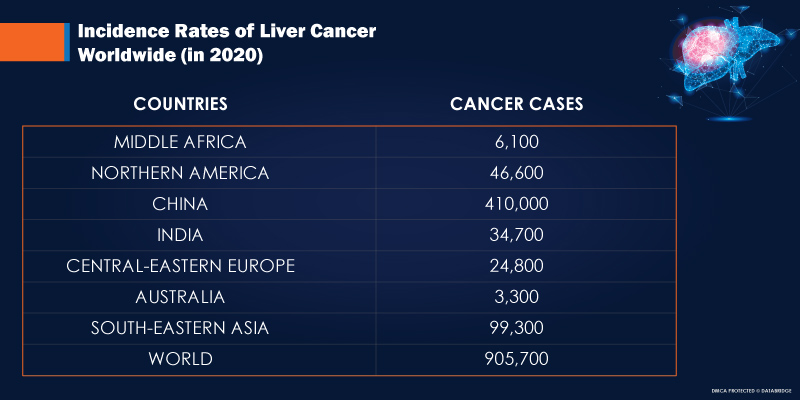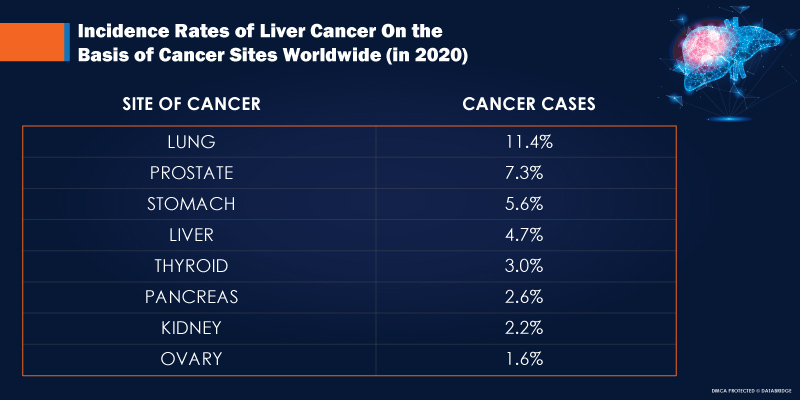Liver cancer is the second-highest cause of cancer-related death in men and the sixth-highest cause of cancer-related death in women worldwide. Liver cancer is more common in low-income and middle-income countries than in developed countries. According to the National Cancer Institute, approximately 40,700 cases of liver cancer are expected to be newly diagnosed, and about 29,000 patients will die from liver cancer in the U.S. in 2017. The incidence of liver cancer is increasing every year. This means that cancer of the bile ducts is a major public health problem.
The most common type of primary liver cancer is hepatocellular carcinoma. The USA and Europe have higher levels of alcohol consumption than other countries. Conversely, chronic hepatitis B HBV infection is the major risk factor in low-income and middle-income countries. The ratio of alcohol abuse to all etiologies of HCC varies according to the country and alcohol abuse is reported to be responsible for approximately 15-30% of HCC. However, the appropriate methods for surveilling patients with alcohol use disorder to facilitate the early-stage diagnosis of HCC remain to be determined, and mechanisms through which alcohol consumption is involved in initiating HCC remain unclear.
The study involved around 1.3 million women and stated a 41% increased risk of liver cancer in the nondrinkers than those drinking ≤ 2 drinks per week. Though, the lifelong non-drinkers were not teased out from those who had stopped drinking. The latest study generated a similar finding and provided a more detailed dissection of the association between alcohol use and HCC. The latest umbrella review of meta-analyses also showed that low alcohol consumption was related to a 27% decreased risk of liver cancer. In contrast to this, some studies stated no association or proportionality between alcohol use and the risk of liver cancer. Furthermore, moderate wine drinkers were seen to have decreased risk of becoming heavy drinkers, and people who preferred wine had healthier diets than those who preferred beer or spirits, which may explain the "positive role" of wine drinking.
Our DBMR team investigated the alcoholic beverages market and witnessed that the rise in demand for alcoholic beverages from the millennial population acts as one of the major factors driving the growth of alcoholic beverages market. North America dominates the alcoholic beverages market because of the high disposable income within the region. Asia-Pacific is expected to witness fastest growth during the forecast period of 2021 to 2028 due to the region's huge investments in marketing and advertisement strategies.
To know more about the study, kindly visit: https://www.databridgemarketresearch.com/reports/europe-alcoholic-beverages-market
There were an estimated 19.3 million new cases (18.1 million excluding NMSC, except basal cell carcinoma) and 10 million cancer deaths (9.9 million excluding NMSC, except basal cell carcinoma) worldwide in 2020.
Risk of Liver Cirrhosis and HCC
According to a WHO report, approximately 280 million individuals or 4.1 of the population aged 15 years meet the definition of alcohol dependence and the harmful use of alcohol. The prevalence is almost the same as the prevalence of hepatitis B and is four times higher than the prevalence of hepatitis C. The large population HCC screening such as ultrasonography or the measurement of serum tumour marker levels for all of such patients would lead to huge medical costs. In this respect , the American Association for the Study of Liver Diseases AASLD recommends that patients with Childs classification A B cirrhosis undergo surveillance for HCC using ultrasonography with or without alpha-fetoprotein measurement every 6 months and does not recommend the modification of the surveillance strategy based on the etiology of liver disease the strategy of which is almost the same as that recommended by the European Association for the Study of the Liver.
Our DBMR team investigated the liver cirrhosis drugs market and investigated the rise in the research and development activities, and emerging new markets will provide beneficial opportunities for the liver cirrhosis drugs market in the forecast period of 2022-2029. North America dominates the liver cirrhosis drugs market due to the presence of major key players, favourable reimbursement scenario and well-developed healthcare infrastructure in this region. Europe is expected to grow during the forecast period of 2022-2029 due to the increase in the chronic consumption of tobacco smoke and alcohol in this region.
To know more about the study, kindly visit: https://www.databridgemarketresearch.com/reports/global-liver-cirrhosis-drugs-market
It has been witnessed that around 10%–20% of heavy drinkers have cirrhosis. Additionally, numerous previous studies that have evaluated the annual incidence of HCC in patients with alcohol-induced liver cirrhosis have showed the rate to be 1.9%–2.6%.Thus, it might be suitable to perform HCC surveillance for patients with alcoholic liver cirrhosis. However, nearly 20%–30% of HCC in patients with cirrhosis were diagnosed at a non-early stage.
Possible Risk Factors
- Amount of Ethanol Intake
A high amount of alcohol intake has been shown to be a major risk factor for liver cirrhosis and HCC. Alcohol consumption and the risk of cirrhosis and HCC are directly correlated. An alcohol intake of 30–50 g/day increases the chances of liver cirrhosis, however, an alcohol intake of >60–100 g/day increases the chances for HCC. In terms of the total amount of alcohol intake during a patient's lifetime, an alcohol consumption of >600 000 mL majorly increased the risk of HCC development. Thus, it can be said that the amount of ethanol consumption might proof to be an indication of the risk of liver cirrhosis and HCC.
- Correlation of Hepatitis Virus
It has been stated that the incidence of hepatitis C virus (HCV) infection in alcoholic patients is 16.32%, which is much higher than that in the general population. In patients with a high alcohol intake, the coexistence of HCV has been shown to increase the risk of alcohol-associated liver cirrhosis. Patients with coexisting hepatitis B s antigen HBsAg-positivity are at higher risk of developing fibrosis and HCC. In addition to this, self-resolved HBV infection can be a major risk factor for developing HCC in patients with alcoholic cirrhosis.
Our DBMR team investigated the viral hepatitis market and witnessed that North America dominates the viral hepatitis market because of the growing presence of major key players and rising number of research and development activities will further propel the market's growth rate in this region. Additionally, an increase in the number of FDA approved drugs will further propel the market's growth rate in this region. Asia-Pacific are expected to grow during the forecast period due to surging number of generic manufacturers and growing government initiatives in this region. Also, the development of healthcare infrastructure will further propel themarket's growth rate in this region.
To know more about the study, kindly visit: https://www.databridgemarketresearch.com/reports/global-viral-hepatitis-market
- Diabetes and Obesity
Through several studies and scientific research, it has been well understood that diabetes is a risk factor for HCC. Numerous meta-analyses have shown that diabetes is considerably associated with HCC. Though the mechanisms of the synergistic effect between alcohol intake and diabetes are unknown, some mechanisms have been suggested to highlight the development of diabetes or obesity-induced HCC in patients suffering from non-alcoholic steatohepatitis. In terms of cost-effective surveillance, a recent cohort study examined the possible predictors of HCC in 3544 patients with diabetes without viral hepatitis and suggested that a DM-HCC risk score included age >65 years, low triglyceride levels and high gamma-glutamyl transferase levels.
Our DBMR team investigated the diabetes treatments market and witnessed the market grow at a CAGR of 3.45% in the above-mentioned forecast period. North America dominates the diabetes treatments market due to growing investments in research and development activities by many government organizations and rise in the prevalence of diabetes in this region.
To know more about the study, kindly visit: https://www.databridgemarketresearch.com/reports/global-diabetes-treatments-market
Key Highlights:
- There were more than 900,000 new cases of liver cancer in 2020
- There is an estimated 19.3 million new cancer cases, and almost 10.0 million cancer deaths occurred in 2020 globally
- Alcohol consumption can increase the risk of developing hepatocellular carcinoma (HCC)
- Continuous alcohol consumption can influence outcomes in patients with HCC who undergo transarterial chemoembolization (TACE)
- A large alcohol intake, the coexistence of diabetes and hepatitis virus infection, and female gender are major risk factors











